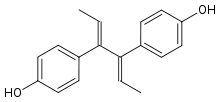Dienestrol
 | |
| Clinical data | |
|---|---|
| AHFS/Drugs.com | Micromedex Detailed Consumer Information |
| ATC code | |
| Pharmacokinetic data | |
| Protein binding | 50 to 80% |
| Identifiers | |
| |
| CAS Number | |
| PubChem CID | |
| IUPHAR/BPS | |
| DrugBank | |
| ChemSpider | |
| UNII | |
| KEGG | |
| ChEBI | |
| ChEMBL | |
| ECHA InfoCard | 100.001.381 |
| Chemical and physical data | |
| Formula | C18H18O2 |
| Molar mass | 266.334 g/mol |
| 3D model (JSmol) | |
| |
| |
| | |
Dienestrol (INN, USAN) (brand names Ortho Dienestrol, Dienoestrol, Dienoestrol Ortho, Sexadien, Denestrolin, Dienol, Dinovex, Follormon, Oestrodiene, Synestrol, numerous others), also known as dienoestrol (BAN), is a synthetic, nonsteroidal estrogen of the stilbestrol group used to treat menopausal symptoms in the United States and Europe.[1][2][3][4] It was introduced in the U.S. in 1947 by Schering as Synestrol and in France in 1948 as Cycladiene.[4] Dienestrol is a close analogue of diethylstilbestrol.[5] It has approximately 223% and 404% of the affinity of estradiol at the ERα and ERβ, respectively.[6]
Dienestrol diacetate (brand names Faragynol, Gynocyrol, others) also exists and is used medically.[2]
See also
References
- ↑ Index Nominum 2000: International Drug Directory. Taylor & Francis. January 2000. pp. 331–. ISBN 978-3-88763-075-1.
- 1 2 J. Elks (14 November 2014). The Dictionary of Drugs: Chemical Data: Chemical Data, Structures and Bibliographies. Springer. pp. 390–. ISBN 978-1-4757-2085-3.
- ↑ Muller (19 June 1998). European Drug Index: European Drug Registrations, Fourth Edition. CRC Press. pp. 361–. ISBN 978-3-7692-2114-5.
- 1 2 William Andrew Publishing (22 October 2013). Pharmaceutical Manufacturing Encyclopedia, 3rd Edition. Elsevier. pp. 1286–. ISBN 978-0-8155-1856-3.
- ↑ VITAMINS AND HORMONES. Academic Press. 1 January 1945. pp. 233–. ISBN 978-0-08-086600-0.
- ↑ Kuiper GG, Carlsson B, Grandien K, Enmark E, Häggblad J, Nilsson S, Gustafsson JA (1997). "Comparison of the ligand binding specificity and transcript tissue distribution of estrogen receptors alpha and beta". Endocrinology. 138 (3): 863–70. PMID 9048584. doi:10.1210/endo.138.3.4979.
This article is issued from
Wikipedia.
The text is licensed under Creative Commons - Attribution - Sharealike.
Additional terms may apply for the media files.